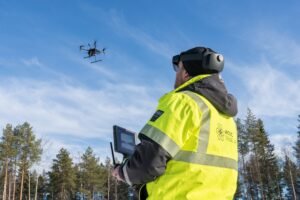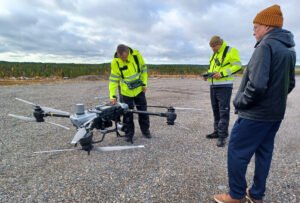The development and adoption of artificial intelligence technologies is largely controlled by a small group of wealthy countries and large technology companies. This trend also applies to GeoAI, which combines spatial data with machine learning. The competition for technological leadership is intensifying, and geopolitical tensions are making the situation more complicated in various parts of the world. From a global perspective, China and the United States have been at the centre of AI development, including GeoAI.
“The majority of GeoAI researchers are currently of Chinese origin, as reflected in the authors of scientific studies. This indicates both a high level of interest in the subject and significant investment in research in this field by China, even though many of the researchers work outside the country, for example in the United States and Europe,” says Assistant Professor Henrikki Tenkanen from Aalto University.
Responsible AI vs. the realities of international growth
The EU seeks to promote AI based on ethical principles, data security, and responsibility. However, efforts to promote ethical AI may face resistance in an international context. The regulatory frameworks of different countries can affect the smooth international adoption and commercialisation of different technologies.

“As a researcher, I naturally hope that AI development will bring social benefits rather than just promoting corporate cash flow. However, this is a challenging equation because AI development is so strongly linked to competitiveness,” reflects Tenkanen.
Sustainability challenges and growing inequality
One of the major global challenges in developing GeoAI is ensuring the quality and availability of data. Even the best technological methods will not help if the input data used for training the models is poor.
“It has been estimated that the global competitive landscape will only widen the gap between the global South and the leading AI countries. The risk is that the digital divide between countries regarding the utilisation of technologies and realizing their benefits will widen even further. The widening gap is due to differing access to high-quality data, computational resources, and necessary education,” Tenkanen explains.
Geography also contributes to the widening digital divide from Finland’s perspective. Data centres are being built here because we can offer cool conditions, water for cooling, a stable power grid, and a reliable society that companies can trust. This is not the case in many other countries – and climate change is only making the situation worse.
“The buzz around artificial intelligence requires enormous resources and poses a significant challenge. Former Google CEO Eric Schmidt recently estimated that, by 2030, dozens of new nuclear power plants would need to be built in the United States alone to meet the energy demands of data centres and support AI operations. From a sustainability perspective, it raises concerns about how these technologies can be operated sustainably in the future,” Tenkanen ponders. Responsibility and ethics are not just EU requirements but can also be competitive advantages in the global market.
Are transparency and trust shared values?
Trust is an essential factor in the development of GeoAI. If people do not understand how artificial intelligence reaches its conclusions, they will not trust the information it produces. Therefore, developers should provide clear documentation and explanations of how AI systems make decisions to foster trust. There may not be global consensus on these developments.
“I agree with the European perspective that it is problematic if we do not understand what artificial intelligence does. From a competitiveness standpoint, there are certainly different national interests at stake, and we in Europe are also concerned about whether we can keep up with the competition,” Tenkanen reflects.
Global players can facilitate dialogue by establishing common rules and standards for GeoAI developers.
Searching for solutions
GeoAI has enormous potential, as it enables us to better understand what is happening in the world. Foundation models, for instance, can analyse large datasets and study various phenomena quickly and efficiently. This significantly speeds up research. There are opportunities to solve urbanisation problems that affect everyone globally.
“Openness is essential. If models can only be used by their creators, everyone else will have to do the same work again, wasting valuable resources. That’s why it’s great that the Clay Foundation model, for example, is open and available for others to use,” says Henrikki Tenkanen.
Want to dive deeper into how AI and geospatial data work together? A new free online course, “Location and AI: Deep Dive”, launched by the Location Innovation Hub, shows you the basics of GeoAI, practical applications, and how to assess the reliability of AI-generated geospatial information. You can also learn about ethical and regulatory aspects, foundation models, and how geospatial intelligence can support smarter decision-making. Find out more and start the course for free.






